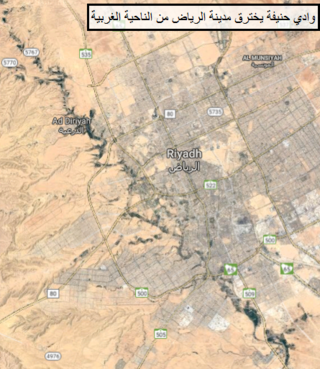
Riyadh, formerly known as Hajr al-Yamamah, is the capital and largest city of Saudi Arabia. It is also the capital of the Riyadh Province and the centre of the Riyadh Governorate.

The Aga Khan Award for Architecture (AKAA) is an architectural prize established by Aga Khan IV in 1977. It aims to identify and reward architectural concepts that successfully address the needs and aspirations of Muslim societies in the fields of contemporary design, social housing, community development and improvement, restoration, reuse and area conservation, as well as landscape design and improvement of the environment.
The year 1987 in architecture involved some significant architectural events and new buildings.
Frei Paul Otto was a German architect and structural engineer noted for his use of lightweight structures, in particular tensile and membrane structures, including the roof of the Olympic Stadium in Munich for the 1972 Summer Olympics.

Kingdom Centre, formerly Kingdom Tower, is a 99-story, 302.3 m (992 ft) skyscraper in the al-Olaya district of Riyadh, Saudi Arabia. When completed in 2002, it overtook the 267-meter (876 ft) Faisaliyah Tower as the tallest tower in Saudi Arabia. It has since been surpassed and, as of 2021, is the fifth-tallest skyscraper in the country, whose tallest two buildings are the Abraj Al Bait Towers and the Capital Market Authority Tower. It is the world's third-tallest building with a hole after the Shanghai World Financial Center and the 85 Sky Tower in Taiwan.
Abdel-Wahed El-Wakil is an Egyptian architect who designed over 15 mosques in Saudi Arabia and is considered by many as the foremost contemporary authority in Islamic architecture. For designing in traditional styles, he is also a representative of New Classical Architecture.
Sir Edmund "Ted" Happold was a structural engineer and founder of Buro Happold.

Articles related to Saudi Arabia include:
Buro Happold Limited is a British professional services firm that provides engineering consultancy, design, planning, project management, and consulting services for buildings, infrastructure, and the environment. It was founded in Bath, Somerset, in 1976 by Sir Edmund Happold when he took up a post at the University of Bath as Professor of Architecture and Engineering Design.
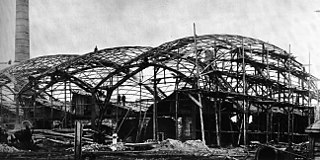
A gridshell is a structure which derives its strength from its double curvature, but is constructed of a grid or lattice.
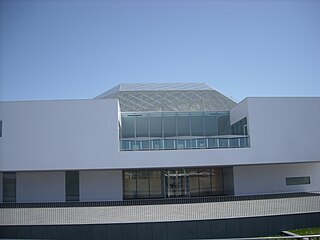
The Delegation of the Ismaili Imamat in Ottawa, Ontario, Canada is representational office of the Ismaili Imamat in Canada and includes the headquarters of the Aga Khan Foundation Canada. It is located between the Embassy of Saudi Arabia and the Lester B. Pearson Building on Sussex Drive. It was opened in 2008.

The Haramain High Speed Railway, also known as the Western railway or Mecca–Medina high-speed railway, is a 453-kilometre-long (281 mi) high-speed rail line in Saudi Arabia. It links the Muslim holy cities of Medina and Mecca via King Abdullah Economic City and Jeddah, using 449.2 kilometres (279.1 mi) of main line and a 3.75-kilometre (2.33 mi) branch connection to King Abdulaziz International Airport (KAIA), in Jeddah. The line was designed for a top speed of 350 km/h (220 mph), and with a service speed of 300 km/h (190 mph).

Rasem Jamal Badran Arabic: راسم بدران, a Saudi Arabian/Jordanian architect from a Palestinian descent whose works are based on a methodological approach in defining Architecture as a continuous dialogue between contemporary needs and historical inherited cultural values.

Omrania and Associates, also known as Omrania, is an international architectural, engineering, and urban planning firm based in Riyadh, Saudi Arabia. Founded in 1973, it specializes in the design of contextual and high-performance design projects.
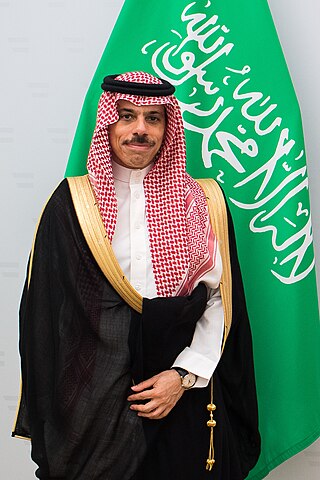
The Ministry of Foreign Affairs is the ministry responsible for handling the Kingdom of Saudi Arabia's external relations. The ministry oversees "political, cultural and financial international relations" and monitors the Kingdom's diplomatic relations. It was created in 1930 by a royal decree issued by King Abdulaziz Al Saud, being the first ministerial body created by the King.
The following is a Gregorian timeline of the history for the city of Riyadh, Saudi Arabia.

King Salman Park (KSP) (Arabic: حديقة الملك سلمان) is an under construction 4102-acre large-scale public park and urban district in Riyadh, Saudi Arabia. It was unveiled in 2019 as one of the public initiatives to increase the green space of Riyadh. Being built on the grounds of former Riyadh Air Base and covering most of King Abdulaziz District, it is slated to be the largest urban park in the world upon its opening in 2024. The park has lent its name to the nearby district of King Salman Neighborhood, both of which are named after King Salman bin Abdulaziz, the ruler of Saudi Arabia since 2015.
The KAFD Grand Mosque is the Juma’ah (Friday) mosque and an architectural centerpiece of the King Abdullah Financial District in Riyadh, Saudi Arabia. The 6,103-square-meter structure sits on a large urban plaza that functions as a public space and, when needed, outdoor prayer area. Inside, the column-free space can accommodate 1,500 prayer spaces over two levels — a large central hall and a mezzanine. Designed by the Riyadh-based architecture and engineering firm Omrania and Associates, the mosque is inspired by the form of the desert rose.
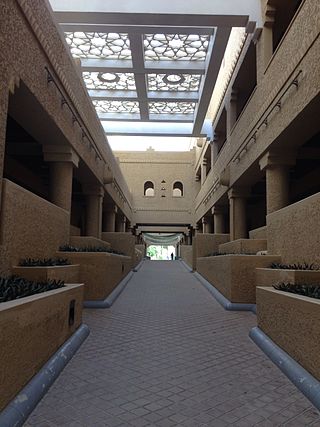
Al-Kindi Plaza, or Al-Kindi Square, is a multipurpose market square in Diplomatic Quarter, Riyadh, Saudi Arabia, located next to the Cultural Palace. Completed in 1986, it is named after the 9th century Arab philosopher and polymath Abu Yusuf al-Kindi. It includes a congregational mosque, library, garden, courtyard and the offices of the Royal Commission for Riyadh City and the MiSK Foundation.






